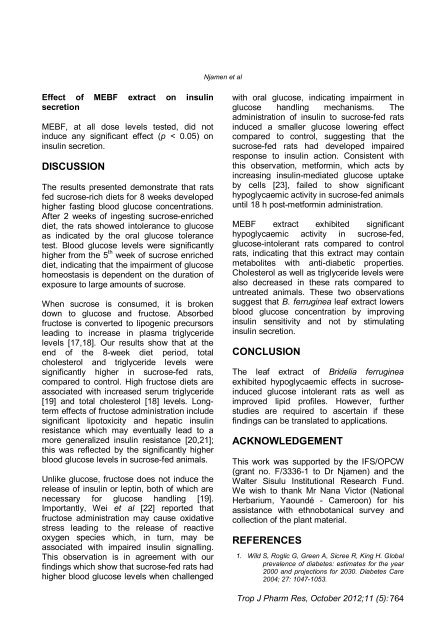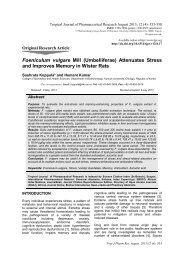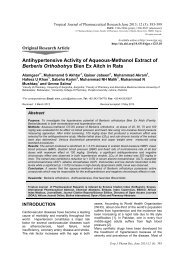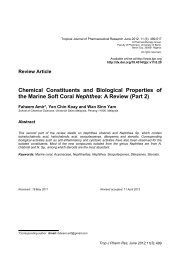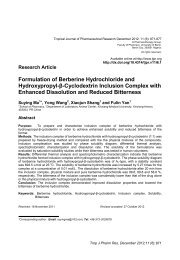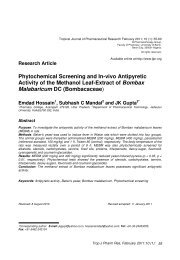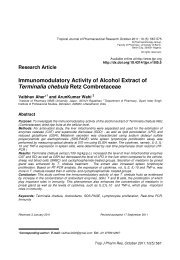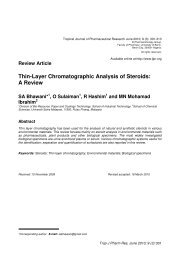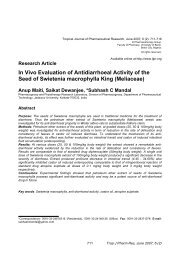Effect of Bridelia ferruginea (Euphorbiaceae) Leaf Extract on ...
Effect of Bridelia ferruginea (Euphorbiaceae) Leaf Extract on ...
Effect of Bridelia ferruginea (Euphorbiaceae) Leaf Extract on ...
Create successful ePaper yourself
Turn your PDF publications into a flip-book with our unique Google optimized e-Paper software.
<str<strong>on</strong>g>Effect</str<strong>on</strong>g> <str<strong>on</strong>g>of</str<strong>on</strong>g> MEBF extract <strong>on</strong> insulin<br />
secreti<strong>on</strong><br />
MEBF, at all dose levels tested, did not<br />
induce any significant effect (p < 0.05) <strong>on</strong><br />
insulin secreti<strong>on</strong>.<br />
DISCUSSION<br />
The results presented dem<strong>on</strong>strate that rats<br />
fed sucrose-rich diets for 8 weeks developed<br />
higher fasting blood glucose c<strong>on</strong>centrati<strong>on</strong>s.<br />
After 2 weeks <str<strong>on</strong>g>of</str<strong>on</strong>g> ingesting sucrose-enriched<br />
diet, the rats showed intolerance to glucose<br />
as indicated by the oral glucose tolerance<br />
test. Blood glucose levels were significantly<br />
higher from the 5 th week <str<strong>on</strong>g>of</str<strong>on</strong>g> sucrose enriched<br />
diet, indicating that the impairment <str<strong>on</strong>g>of</str<strong>on</strong>g> glucose<br />
homeostasis is dependent <strong>on</strong> the durati<strong>on</strong> <str<strong>on</strong>g>of</str<strong>on</strong>g><br />
exposure to large amounts <str<strong>on</strong>g>of</str<strong>on</strong>g> sucrose.<br />
When sucrose is c<strong>on</strong>sumed, it is broken<br />
down to glucose and fructose. Absorbed<br />
fructose is c<strong>on</strong>verted to lipogenic precursors<br />
leading to increase in plasma triglyceride<br />
levels [17,18]. Our results show that at the<br />
end <str<strong>on</strong>g>of</str<strong>on</strong>g> the 8-week diet period, total<br />
cholesterol and triglyceride levels were<br />
significantly higher in sucrose-fed rats,<br />
compared to c<strong>on</strong>trol. High fructose diets are<br />
associated with increased serum triglyceride<br />
[19] and total cholesterol [18] levels. L<strong>on</strong>gterm<br />
effects <str<strong>on</strong>g>of</str<strong>on</strong>g> fructose administrati<strong>on</strong> include<br />
significant lipotoxicity and hepatic insulin<br />
resistance which may eventually lead to a<br />
more generalized insulin resistance [20,21];<br />
this was reflected by the significantly higher<br />
blood glucose levels in sucrose-fed animals.<br />
Unlike glucose, fructose does not induce the<br />
release <str<strong>on</strong>g>of</str<strong>on</strong>g> insulin or leptin, both <str<strong>on</strong>g>of</str<strong>on</strong>g> which are<br />
necessary for glucose handling [19].<br />
Importantly, Wei et al [22] reported that<br />
fructose administrati<strong>on</strong> may cause oxidative<br />
stress leading to the release <str<strong>on</strong>g>of</str<strong>on</strong>g> reactive<br />
oxygen species which, in turn, may be<br />
associated with impaired insulin signalling.<br />
This observati<strong>on</strong> is in agreement with our<br />
findings which show that sucrose-fed rats had<br />
higher blood glucose levels when challenged<br />
Njamen et al<br />
with oral glucose, indicating impairment in<br />
glucose handling mechanisms. The<br />
administrati<strong>on</strong> <str<strong>on</strong>g>of</str<strong>on</strong>g> insulin to sucrose-fed rats<br />
induced a smaller glucose lowering effect<br />
compared to c<strong>on</strong>trol, suggesting that the<br />
sucrose-fed rats had developed impaired<br />
resp<strong>on</strong>se to insulin acti<strong>on</strong>. C<strong>on</strong>sistent with<br />
this observati<strong>on</strong>, metformin, which acts by<br />
increasing insulin-mediated glucose uptake<br />
by cells [23], failed to show significant<br />
hypoglycaemic activity in sucrose-fed animals<br />
until 18 h post-metformin administrati<strong>on</strong>.<br />
MEBF extract exhibited significant<br />
hypoglycaemic activity in sucrose-fed,<br />
glucose-intolerant rats compared to c<strong>on</strong>trol<br />
rats, indicating that this extract may c<strong>on</strong>tain<br />
metabolites with anti-diabetic properties.<br />
Cholesterol as well as triglyceride levels were<br />
also decreased in these rats compared to<br />
untreated animals. These two observati<strong>on</strong>s<br />
suggest that B. <str<strong>on</strong>g>ferruginea</str<strong>on</strong>g> leaf extract lowers<br />
blood glucose c<strong>on</strong>centrati<strong>on</strong> by improving<br />
insulin sensitivity and not by stimulating<br />
insulin secreti<strong>on</strong>.<br />
CONCLUSION<br />
The leaf extract <str<strong>on</strong>g>of</str<strong>on</strong>g> <str<strong>on</strong>g>Bridelia</str<strong>on</strong>g> <str<strong>on</strong>g>ferruginea</str<strong>on</strong>g><br />
exhibited hypoglycaemic effects in sucroseinduced<br />
glucose intolerant rats as well as<br />
improved lipid pr<str<strong>on</strong>g>of</str<strong>on</strong>g>iles. However, further<br />
studies are required to ascertain if these<br />
findings can be translated to applicati<strong>on</strong>s.<br />
ACKNOWLEDGEMENT<br />
This work was supported by the IFS/OPCW<br />
(grant no. F/3336-1 to Dr Njamen) and the<br />
Walter Sisulu Instituti<strong>on</strong>al Research Fund.<br />
We wish to thank Mr Nana Victor (Nati<strong>on</strong>al<br />
Herbarium, Yaoundé - Camero<strong>on</strong>) for his<br />
assistance with ethnobotanical survey and<br />
collecti<strong>on</strong> <str<strong>on</strong>g>of</str<strong>on</strong>g> the plant material.<br />
REFERENCES<br />
1. Wild S, Roglic G, Green A, Sicree R, King H. Global<br />
prevalence <str<strong>on</strong>g>of</str<strong>on</strong>g> diabetes: estimates for the year<br />
2000 and projecti<strong>on</strong>s for 2030. Diabetes Care<br />
2004; 27: 1047-1053.<br />
Trop J Pharm Res, October 2012;11 (5): 764


